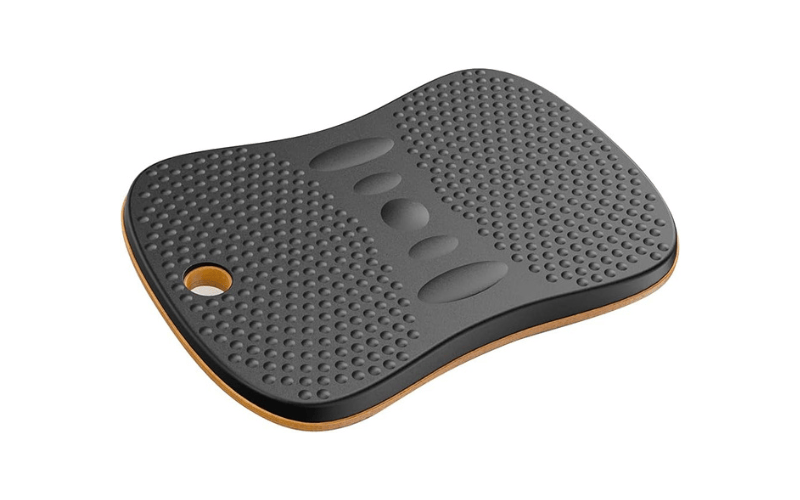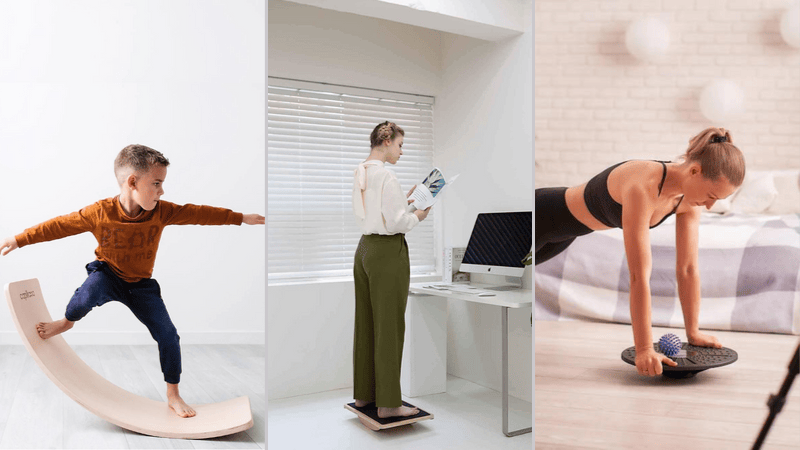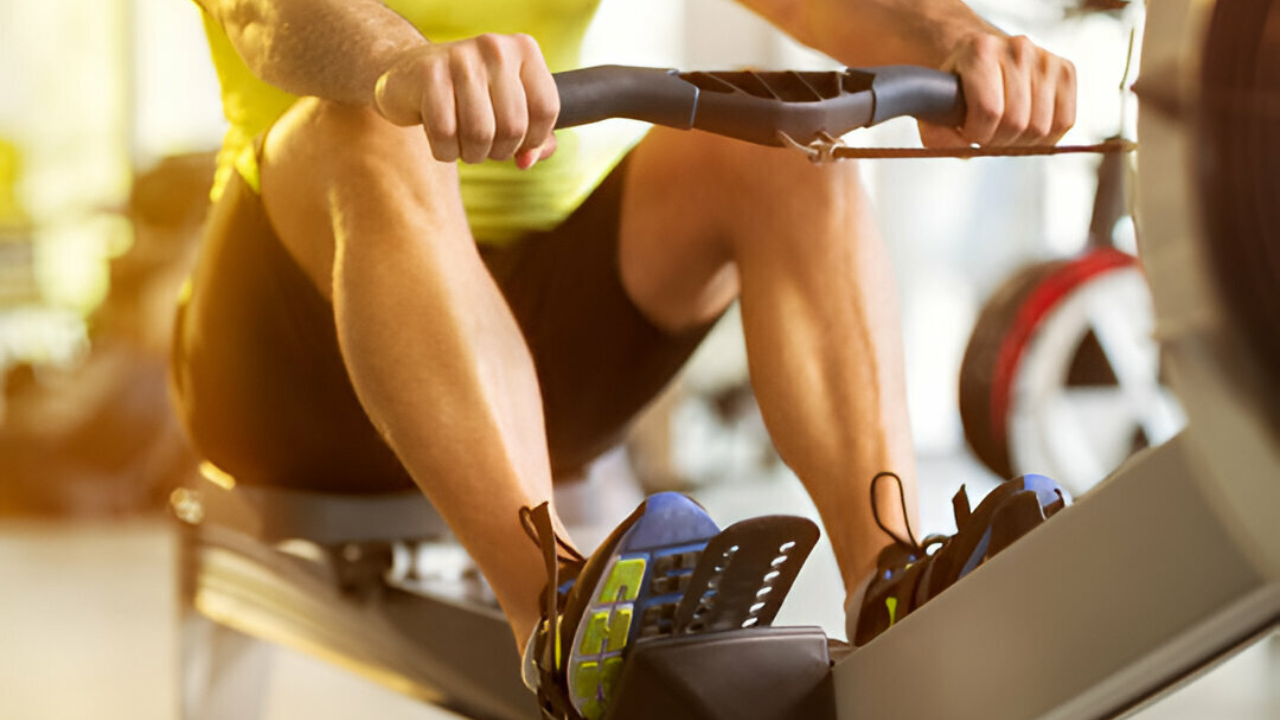You need a balance board to improve your balance and stability. They are also a great addition to your height-adjustable desk, helping you overcome the health implications of sedentary work conditions.
With numerous options available, we've compiled a list of the best balance boards available in Australia to help you easily decide which fits your fitness needs. Our top picks include 10 balance boards for training, beginners, therapy, standing desks, kids, and other use cases.
Our Top Picks
Need to make a quick purchase? Here are our top three balance boards for Australians:

Zukam Balance Board Trainer
Best balance board for most people with 15-ply pressed premium wood, 75 × 28 cm surface area, and a weight capacity of 136 kg.

Desky Balance Board
Best balance board for sit-stand desks with PU mat, premium plywood, anti-scratch and slip surface, and 180 kg weight capacity.

Yes4All Balance Trainer Kit
Best balance board kit for core strength with an antiskid dura-soft grip, 160 kg weight capacity, and an anti-slip surface.
Top 10 Balance Boards for Aussies
Our review of the best balance boards in Australia considered each product’s suitability for different use cases, quality, and user feedback. Here are in-depth analyses and comparisons of the products that made our shortlist.
1. Zukam Balance Board Trainer
Best for Most People

Dimensions: 75 x 28 cm
Roller: Fabric-encased wooden roller
Weight capacity: 136 kg
If you want to improve your balance and strengthen your core, the Zukam Balance Board Trainer is a good choice. This high-quality wooden board, made from 15 layers of wood, can safely hold up to 136 kg. The bottom of the board has a special grip tape that allows the roller to slide easily, and the top has a non-slip grip tape for safe workouts.
Zukam's balance board is also equipped with two secured side stoppers for easy and safe exercises. In addition, you get a resourceful workout guide to effectively learn new drills for standing, sitting, lunges, hip raises, squats, and even military push-ups. The roller balance board is great for families because both adults and kids can use it.
The Zukam Balance Board Trainer not only helps you get better at balancing, but it also strengthens your core, helps you build strength, improves your coordination and stamina, and helps you remember muscle movements.
Pros
- Great fit for most people
- Wide large surface for different workouts
- Good weight limit
- Non-slip top improves safety
- Glides easily on the roller
Cons
- Doesn’t have adjustable stoppers
2. Chattanooga Wooden Rocker Board
Best for Beginner Trainers

Design: Square-shaped
Dimensions: 50 x 50 cm
Finish: Anti-slip surface
This wooden rocker board is our best pick for therapy and beginners. The Chattanooga wooden rocker board has an anti-slip surface of 50 by 50 cm. It is perfect for proprioception and coordination training. Chattanooga wooden rocker board is suitable for recovery from injury and strengthening weakened muscles.
Beginners can use this rocker board as it is not hard to maintain balance. You only need to rock it back and forth to get the balance training you need. It can also be used for vestibular exercises. The board is suitable for use in homes, gyms, physio clinics, and rehabilitation centres.
Pros
- Strong wood with an anti-slip surface
- Large surface of 50 by 50 cm
- Good for therapy and recovery
- Ideal for proprioception and coordination training
- Easy to use for beginners as it rocks only back and forth
Cons
- Limited in movement
3. Desky Balance Board
Best for Standing Desk

Dimensions: 50.8 x 35.2 cm
Weight capacity: 180 kg
Finish: Anti-scratch and anti-slip surface
For a standing desk, the Desky balance board is ideal for dealing with the associated health effects of prolonged standing. It improves your balance and well-being and helps boost productivity. The balance board also helps strengthen your core, enhance blood circulation, and allow you to get in low-stress exercises while working.
The Desky balance board is made from a PU mat and premium plywood. It can hold up to 180 kg and can tilt 8.5° to either side, which helps you work out your core muscles. It also has an anti-scratch and slip protective layer that protects against scratches and slips. This also ensures that the balance board is kept in place on the floor to prevent injuries from slipping.
Desky's balance board is also ideal for slight kneeling behind your standing desk. Plus, its wide surface means you have enough room to move your leg about with little fuss.
Pros
- Quality build
- Generous weight capacity
- Has an anti-slip surface
- Good surface space
- 5 years warranty
Cons
- Learning curve for beginners
4. Randy & Travis Balance Board Trainer
Best With Adjustable Stopper

Finish: Dura-soft grip for traction
Weight capacity: 180 kg
For a balance board that will stay with you as you increase your stability and balance level, choose the Randy & Travis Balance Board Trainer. The balance board is suitable for building agility, balance, stability, body control, and core strength and is equipped with two movable stoppers that accommodate different levels of stability.
Like Desky's balance board, the Randy & Travis board can support up to 180 kg of user weight. The roller has a thick layer of tear-resistant TPE to prevent sliding or slipping. The board's surface is also covered with an anti-skid pad for better grip and a cushioned surface to allow you to use it with bare feet.
Pros
- 12-month warranty
- Has an adjustable stopper
- Can support up to 180 kg
- A large surface
- Has a thick layer of tear-resistant TPE
Cons
- Not a great choice for beginners
5. Yes4All Balance Board Trainer Kit
Best for Core Strength

Dimensions: 79 x 36 cm
Finish: Antiskid dura-soft grip
Weight capacity: 160 kg
The Yes4All Balance Board Trainer is adaptable enough to give new and seasoned athletes an enjoyable and equally effective drill. It improves your endurance, core strength, balance, coordination, and muscle memory. The kit consists of a rocker, an air cushion, a roller made of wood, and a balance board.
Yes4All's balance board is made from high-grade wood that can support up to 160 kg of weight. Its rocking base allows beginners to learn how to balance on the board before moving on to more difficult bases. This makes it a great option for trying new exercises.
The balance board also has a Durasoft grip on the surface, providing a good grip and smoothness. This makes it safe and comfortable to use, whether you're wearing shoes or not. We recommend it if you want to challenge your current routine. You get numerous drills to improve your core strength and balance.
Pros
- Lightweight material
- Has an anti-slip surface
- Suitable for beginners
- Good durability
Cons
- Assembly can be tricky
6. Heavy Duty Balance Board
Best Budget Balance Board

Dimensions: 39.37 x 7.62 cm
Weight capacity: 250 kg
Finish: Non-skid surface
If you are unsure about spending big on your balance board, you can start with the Heavy Duty Balance Board. It's complete enough to give you a fair experience of using a balance board without spending too much. You get a non-skid surface that provides good stability, balance, strength, and rehabilitation training.
The Heavy Duty 15.5-inch (39.37 cm) balance board has an adjustable height to vary the difficulty, which is impressive considering it's a budget pick. But even better, the balance board has a weight capacity of 250 kg, the highest on our list. The only downside is it's not very beginner-friendly, as it allows movements from all angles.
Pros
- Affordable
- Non-skid surface
- Offers movement from all angles
- Builds core strength, stability, and general fitness
- Adjustable height to vary the difficulty
Cons
- Not beginner-friendly
7. Randy & Travis Balance Board Beam Seesaw
Best Balance Board for Kids

Dimensions: 92 x 29.5 cm
Design: Curved surface; Smooth finish
Weight capacity: 100 kg
The best balance board for kids is the Randy & Travis Balance Board Beam Seesaw. It is a simple wooden balance board made from beechwood, which is light yet sturdy enough to provide support. It makes a good board for helping your kids build balance for sports like gymnastics, skating, surfing, skiing, and other sports.
The Randy & Travis Beam Seesaw Balance Board has a maximum weight capacity of 100 kg. This makes it accommodate up to two kids at a time—not recommended, though. Your kids can use it as a seesaw with another child or for other applications like a boat or bridge when turned upside down.
Pros
- Lightweight beechwood balance board
- Can support up to 100 kg
- Perfect for kids to build balance
- Makes for an intuitive play tool for kids
Cons
- Too basic
8. Revolution Swell 2.0
Best Surf Balance Board

Finish: Durasoft traction
Stops: Magswitch adjustable stops
Weight capacity: 204 kg
Do you love to surf, but you're stuck in Alice Springs, thousands of kilometres away from the nearest beach? No problem, you can start practicing for when you get the chance with the Revolution Swell 2.0. The balance board allows you to dial in your pop-ups and prepare you for a real surfing trip to the ocean.
The Revolution Swell has a very long rocker that makes it easy to rock side to side and front to back. The board has Magswitch adjustable stops that you can change without any tools. If you're starting out, you can make the rolling distance shorter or longer as you get better at using the board. And if you want a real challenge during your workouts, you can take off the roller stops.
The heavy-duty deck also has a premium reinforced construction with a high weight limit of 204 kg. Similarly, the deck has a Durasoft traction surface that offers a good combination of grip and cushioning for your feet. We recommend it for wake surfers, longboarders, paddleboarders, and kiteboarders.
Pros
- Extra-long rocker
- Magnetic stop system
- Durasoft traction surface
- Suitable for a wide range of workouts
- High weight limit
Cons
- Expensive option
9. Plankpad Balance Board
Best Balance Board for Planking

Dimensions: 50 x 36 cm
Weight capacity: 180 kg
Special feature: Plankpad app
With the Plankpad Balance Board, you can get in shape while playing fun games. The board comes with a fitness and game app that is controlled by how you move during your workout. This means you can work out your abs, chest, back, legs, glutes, shoulders, arms, and neck all while playing exciting games.
For build quality and performance, the balance board is made from high-quality materials and can hold up to 180 kg. The deck has a soft foam top that makes planking comfortable. Plus, the manufacturer includes a special mat that stops you from slipping, protects your floor, and keeps things quiet.
Pros
- Made of premium wood material
- Synched with the Plankpad app
- Special deck foam for comfortable planking
- Included mat protect your floor and prevents noise
- Only optimised for planking
Cons
- Expensive balance board trainer
10. StrongTek Evolve Balance Board
Best Anti-Fatigue Balance Board

Dimensions: 45.7 x 35.3 cm
Finish: Non-skid surface
Weight capacity: 158.76 kg
The heavy-duty anti-fatigue balance board from StrongTek is uniquely designed to keep your body, core, and legs active to reduce fatigue, improve focus, and alleviate foot tension. It's another balance board suitable for use with a height-adjustable desk. The best thing is it doesn’t interrupt your workflow. The best part is it doesn't get in the way of your work. So, you'll feel less tired and be able to focus better and work more efficiently.
The StrongTek balance board is made from high-quality PU material on top and has a grippy material on the bottom to stop it from sliding or slipping. The board is angled just right for workouts that are easy on your body, and it can tilt up to 8.5 degrees. This makes it easy to use at home or at your office desk. It's a good choice for physical therapy and building core strength.
Pros
- Good for low-impact exercises
- Textured pressure points help relieve fatigue
- Non-skid surface for safe and comfortable workouts
- Grippy bottom keeps the board from slipping
- 8.5-degree tilt angle for superior core engagement
Cons
- Expensive option
- Not be suitable for high-impact workouts
Types of Balance Boards
Balance boards have various designs and styles, each catering to specific needs and skill levels. Understanding the different types of balance boards will help you make an informed choice when selecting the one that suits your fitness goals and preferences.
Type #1 - Wobble Boards

Wobble boards have a flat top and a dome-shaped, unstable bottom. This design allows the board to move in different directions, providing a challenging workout for your core and lower body muscles. Their benefits include improved balance and posture, aid in rehabilitation, prevention of lower body injuries, and increased core strength.
We recommend wobble boards for beginners as they provide a moderate level of instability that is not too overwhelming. They are also commonly used in rehabilitation settings to help individuals recover from lower body injuries, particularly ankle sprains.
Type #2 - Rocker Boards
Rocker boards feature a curved or flat design, allowing you to move from side to side or front to back. They target various muscle groups, including the core, legs, and back, and are suitable for users ranging from beginners to advanced levels.
Rocker boards are often used in athletic training programs to improve balance, coordination, and strength. To choose a rocker board, consider a curved or flat design for a unique balance challenge, material options such as wood or plastic, depending on your preference, and sturdiness to withstand regular use.
Type #3 - Roller Boards

Roller boards have a rolling mechanism that provides a dynamic balance challenge. They are known for their core strengthening benefits. To choose the best roller board for your exercising needs, consider the types of wheels (single or multi) based on your skill level and look for adjustability features and safety mechanisms.
Type #4 - Multi-Directional Boards
Multi-directional balance boards offer full 360-degree movement, simulating real-life balance scenarios. They are designed to move in all directions and with free rotation. This enables you to move the board around in different directions instead of a side-to-side motion like rocker balance boards.
Multi-directional boards are used in sports-specific training due to their versatile movement capabilities. They require more skill and balance compared to other types of balance boards and are ideal for dynamic balance exercises, functional training exercises, core strength, and injury prevention training.
Choosing the Right Balance Board for Your Fitness Goals

Every balance board we mentioned has its own special features and uses. So, how do you choose the right one? First, consider why you need the balance board. It could be for a specific purpose or for many different activities. The best choice will be the one that fits all your needs. Once you know why you need a balance board, consider the following:
Board Material
Balance boards are made of either plastic, wood, or a combination. Considering the weight capacity of the material can help decide which material is better. Generally, woods are expected to be more durable as sturdy timber, like beech wood, is used. Plastic materials can be more comfortable to stand upon.
Many wooden surfaces are covered with a non-skid material to help soothe the feet and avoid slipping. Some plastic balance boards have spikes on the surface to increase their therapeutic effects on the feet. Some roller boards also come with additions of a non-skid mat.
Board Type
Balance boards are usually of five main types. But in common usages, we can keep the types at four. As explained above, choose which board type best suits your unique needs and fitness level.
Rolling Length
This is particular to roller boards. Some roller boards have adjustable stoppers that restrict the rolling length. These make them suitable for different levels of training. It is essential to know how far the board can roll. The rolling length will help determine how much control you can have over the boards. You won’t want to buy a board beyond your control level.
Board Angle
For wobble and rocker boards, the tilting angle of the board is essential. If you seek a big balance challenge, a board with an increased tilt angle is good for you. Wobble boards are usually able to tilt and twist in every direction. That makes them excellent for advanced balance training. Rocker boards usually tilt in limited ways, making them the most stable balance board.
Balance Board Exercises

Here are some exercises you can do with a balance board. Remember to always warm up before starting these exercises and cool down afterward. If you're new, let someone spot you or use a wall for support until you get used to it.
- Starting Position: Stand with your feet hip-distance apart and find your balance on the board. Keep your spine neutral and your posture upright. Shift your weight as needed so the edges of the board don’t touch the floor. Hold for at least 30 seconds.
- Front-to-Back Rock: Stand on the board with both feet. Rock the board front to back while maintaining balance.
- Side-to-Side Rock: Stand on the board with both feet. Rock the board from side to side while maintaining balance.
- Round the Clock: Imagine you're standing in the center of a clock face and trying to tilt the board towards each number in turn.
- Plank: Get into a push-up position with your hands on the board and your feet on the ground.
- Mini Squat: Stand on the board with both feet. Lower into a mini squat, then stand back up.
- Push-Ups: Start in a high plank position with your hands on the balance board and your feet on the ground. Lower your body towards the board and then push back up.
- Single-Leg Stand: Stand on the board with one foot, trying to maintain balance.
Workouts on the balance board require the use of many different muscle groups, but the heavy lifting is done by the abdominal and thigh muscles, keeping your physique and muscles in good shape.
Safety Tips for Using Balance Boards
Using a balance board can be a fun and effective way to improve your balance and core strength. However, it's important to use it safely to prevent injuries. Here are some safety tips for using balance boards:
- Use in an Open Area: Make sure the area around you is clear of obstacles that could cause injuries, such as tables, chairs, or toys.
- Proper Footwear: Use the board with bare feet or sneakers for better grip and balance.
- Use a Spotter: Especially if you're a beginner, having someone nearby who can support you if you fall can improve safety.
- Practice on the Right Surface: Balance boards are safest when used on smooth, hard surfaces or carpets. Wooden balance boards especially shouldn’t be used on rough terrain.
- Start Slowly and Carefully: Don't just jump on the board and hope for the best. Start slowly and carefully, and make sure you know how to use the board properly before starting any exercises.
- Keep Hands on the Wall: When first learning, keep your hands posted on the wall while rocking back and forth on the board to get familiar with it.
- Protect Your Surroundings: Balance boards can shoot out from under you and damage whatever they smash into. So, use them in an area where a flying board cannot do any damage.
Remember, safety should always be your top priority when using a balance board or any other fitness equipment.
Frequently Asked Questions (FAQs)
Here are some frequently asked questions on the use of balance boards in Australia.
Which type of balance board is best?
While there are many types of balance boards to choose from, including rocker, wobble, and roller boards, the board size is the most important factor to consider. For beginners, a larger board is generally recommended, while more experienced users may benefit from a smaller board for a more intense workout.
Are balance boards worth the money?
Yes, balance boards can be the best investment for your health. They increase motor skills, improve balance, are ideal for improving posture, help with injury rehabilitation, and are a go-to suggestion for various workout plans and a healthy lifestyle.
How do I choose a balance board?
Always consider the deck size, noise, and impact level when choosing a balance board. If you have a tall height, then a long and wide deck is ideal compared to a narrower one and vice versa. Finally, evaluate the impact level in relation to your workout goals. If you are using it in your office, for example, then consider a low-impact balance board.
What is the difference between a balance board and a wobble board?
A wobble board is a type of balance board with a circular object and an uneven base that is ideal for improving your balance, athleticism, postural strength, coordination, and fall prevention. However, not all balance boards are wobble boards. Some balance boards, like rocker boards, require fewer balancing skills than wobble boards.
What is the safest balance board?
The safest balance board depends on a range of factors, including your skill level, balance and fitness goals, and personal preferences. Some features to look for in a safe balance board may include a non-slip surface, a stable base, and adjustable difficulty levels to allow for gradual progression.
Additionally, it's important to use a balance board properly and follow all safety guidelines, such as using it on a level surface, using proper footwear, and not attempting advanced exercises until you have built up sufficient strength and balance.
Summary
A balance board can significantly help you improve your fitness. For anyone working with a standing desk, balance boards can keep your feet busy and exercise your muscles. For beginners, choosing a rocker board that only moves in two directions is best.
For advanced users like athletes, the roller and wobble boards are great. The greater freedom to move at diverse angles makes them suitable for advanced balance and stability training.







